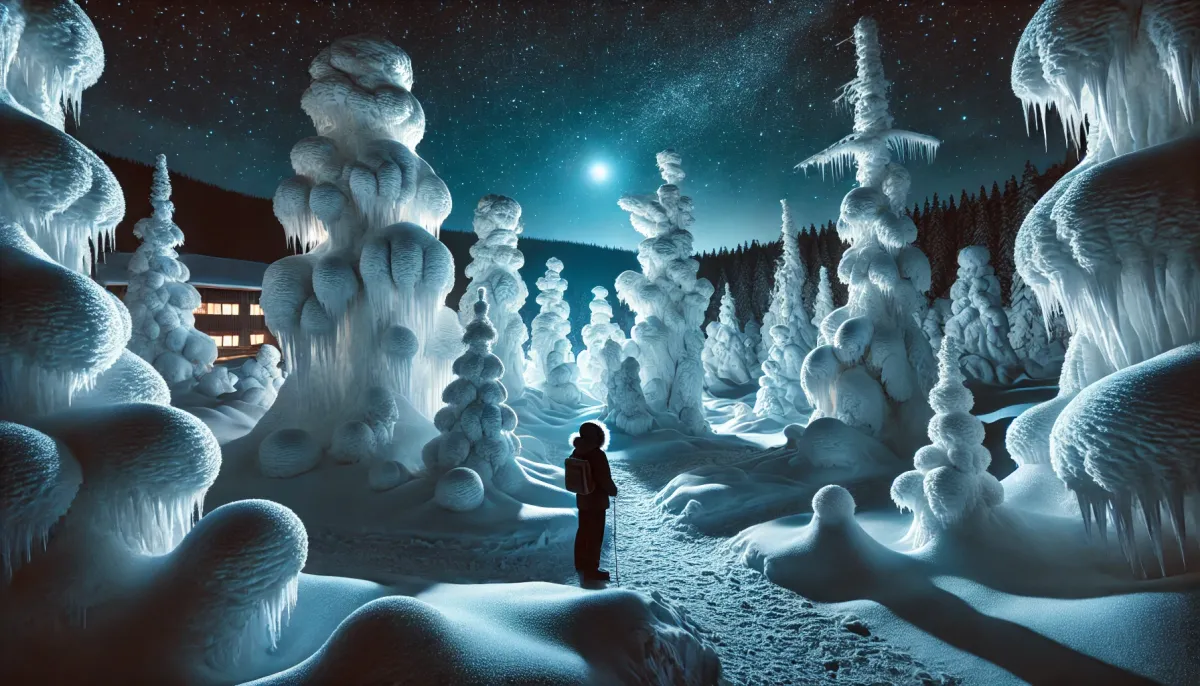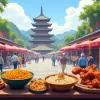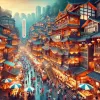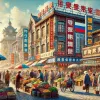Hey everyone, it's Mark here, your friendly neighborhood American backpacker, back with another Asian adventure to share! This time, I ventured into the heart of Japan's Tohoku region for an unforgettable 5-day journey. Why five days specifically? Well, that perfectly aligns with the duration of the Tohoku JR Pass, currently priced at ¥30,000 – a fantastic deal for exploring this often-overlooked gem. From spicy ramen to stunning snow monsters, get ready to be inspired for your own Tohoku escape!
Daruma Dolls and Coastal Delights: Shirakawa and Matsushima
My adventure kicked off with a much-needed bowl of spicy ramen (it was really spicy!) at Ueno Station, conveniently made by a ramen vending machine. Talk about a high-tech start to a trip! From there, the Shinkansen whisked me away to my first stop: Shirakawa, the birthplace of Daruma dolls. With a friend's wedding on the horizon, I couldn't resist picking up a bride and groom Daruma set – talk about a unique gift! The Daruma Land theme park was a blast, offering DIY painting experiences and even Daruma gachapon (capsule toy) machines.
Next up was Matsushima, one of Japan's three most scenic views, and I can see why! The local market was a feast for the senses, overflowing with dried seafood and other delicacies I hadn't seen in regular supermarkets. I was tempted by everything from whole crabs (for making dashi) to dried squid and scallop candies. Even shark fin jerky caught my eye! The market also boasts a fantastic restaurant serving up fresh seafood bowls – a definite must-try. And the grilled fish cakes? Absolutely divine! I finished the day by reflecting at the rebuilt red bridge, a poignant reminder of the 2011 tsunami and a testament to the resilience of the Tohoku people.
Ancient Villages and Modern Comforts: Ouchi-juku and Fukushima
Day two took me to Ouchi-juku, one of Japan's three preserved thatched-roof villages and a former post town. Walking its car-free streets, devoid of power lines, felt like stepping back in time. Don't miss the local specialties here: negi soba (buckwheat noodles with a whole green onion as your utensil!) and amazake, a sweet, non-alcoholic fermented rice drink with beauty-boosting properties. The homemade amazake from a local grandmother was particularly memorable.
My accommodation for the night was the Richmond Hotel in Fukushima, a comfortable and budget-friendly option conveniently located near the JR station. While it lacked the traditional charm of my previous stay at the onsen hotel Onyado Nono in Sendai (which, by the way, was an absolute treat with its included onsen and late-night snacks), the Richmond provided a clean and modern space for a good night's rest.
Acidic Delights and Snowy Wonders: Zao Onsen
The next morning, I fueled up with a bottle of Fukushima's famous Rakuo Coffee Milk – a delightful blend of local milk and a hint of coffee – before heading to Zao Onsen. This mountain town is famous for its hot springs, and I couldn't resist trying out a few of the public bathhouses. For a more private experience, I opted for a soak at Zen Shichi no Yu, a charming onsen with open-air baths and a 50-minute time limit. The strong acidity of the water (pH 1.5!) is quite unique and said to have therapeutic benefits.
But Zao's real claim to fame is its "snow monsters" – fantastical ice-covered trees that form in winter. I was incredibly lucky to witness these otherworldly formations under the magical glow of the nightly illuminations. It was a truly unforgettable experience! I stayed at a local minshuku (guesthouse) near the ropeway station, a convenient base for exploring the area.
Silver Mining History and Culinary Treasures: Ginzan Onsen
The highlight of my trip was undoubtedly Ginzan Onsen, a charming hot spring town nestled deep in the mountains. The main street, just 400 meters long, is lined with beautifully preserved Taisho-era wooden buildings, connected by a series of picturesque bridges. A must-try here is the agedashi tofu (deep-fried tofu) and yudofu (boiled tofu) from Nogawa Tofu Shop – the melt-in-your-mouth texture is unlike anything I've experienced! At night, the town transforms into a magical wonderland as the warm glow from the onsen ryokans (inns) illuminates the snow-covered streets. It was pure magic!
Trip Costs and Final Thoughts
My Tohoku adventure proved that you don't have to break the bank to experience the magic of Japan. Here’s a quick breakdown of my expenses:
| Expense | Cost (Approx. USD) | Notes |
|---|---|---|
| Roundtrip Airfare (US to Narita) | $750 | Budget airline |
| 4 Nights Accommodation | $800 | Mix of business hotels and traditional inns |
| 5-Day JR East Pass | $200 | Essential for cost-effective train travel |
| Food, Activities, etc. | $250 | Estimated |
| Total | $2000 | This is a rough estimate and can vary based on your choices. |
While budget travel isn't always the cheapest option, the freedom to explore at my own pace and discover hidden gems made every yen worthwhile. Tohoku, with its warm hospitality, stunning landscapes, and unique cultural experiences, has definitely earned a special place in my heart.







